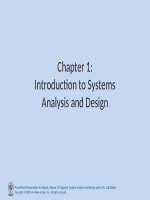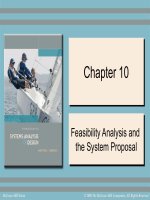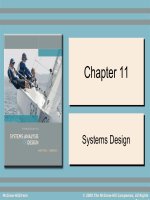Lecture Introduction to systems analysis and design Chapter 8 Whitten, Bentley
Bạn đang xem bản rút gọn của tài liệu. Xem và tải ngay bản đầy đủ của tài liệu tại đây (2.02 MB, 56 trang )
Chapter
Chapter 88
Process
Process Modeling
Modeling
McGraw-Hill/Irwin
© 2008 The McGraw-Hill Companies, All Rights
Objectives
•
•
•
•
•
•
•
•
•
8-2
Define process modeling and explain its benefits.
Recognize and understand basic concepts and constructs of
a process model.
Read and interpret a data flow diagram.
Explain when to construct process models and where to
store them.
Construct a context diagram to illustrate a system’s
interfaces with its environment.
Identify use cases, external and temporal business events.
Perform event partitioning and organize events in a
functional decomposition diagram.
Draw event diagrams and merge them into a system diagram.
Draw primitive data flow diagrams and describe the
elementary data flows in terms of data structures and
procedural logic (Structured English and decision tables),
respectively.
Process Modeling and DFDs
Process modeling – a technique used to organize
and document a system’s processes.
–
–
–
–
Flow of data through processes
Logic
Policies
Procedures
Data flow diagram (DFD) – a process model used to
depict the flow of data through a system and the
work or processing performed by the system.
Synonyms are bubble chart, transformation graph,
and process model.
8-3
– The DFD has also become a popular tool for business
process redesign.
Simple Data Flow Diagram
8-4
External Agents
External agent – an outside person, unit, system, or
organization that interacts with a system. Also
called an external entity.
– External agents define the “boundary” or
scope of a system being modeled.
– Almost always one of the following:
• Office, department, division.
• An external organization or agency.
Gane and Sarson shape
• Another business or another
information system.
• One of system’s end-users or managers
– Named with descriptive, singular noun
DeMarco/Yourdon shape
8-5
Data Stores
Data store – stored data intended for later
use. Synonyms are file and database.
– Frequently implemented as a file or database.
– A data store is “data at rest” compared to a data
flow that is “data in motion.”
– Almost always one of the following:
•
•
•
•
•
8-6
Persons (or groups of persons)
Places
Objects
Events (about which data is captured)
Concepts (about which data is important)
– Data stores depicted on a DFD store
all instances of data entities
(depicted on an ERD)
– Named with plural noun
Gane and Sarson shape
DeMarco/Yourdon shape
Process Concepts
Process – work performed by a system in response to
incoming data flows or conditions. A synonym is
transform.
– All information systems include
processes - usually many of them
– Processes respond to business
events and conditions and transform
data into useful information
Gane and Sarson shape
– Modeling processes helps us to understand the
interactions with the system's environment, other
systems, and other processes.
– Named with a strong action verb followed by object
clause describing what the work is performed on/for .
8-7
The System is Itself a Process
8-8
Process Decomposition
Decomposition – the act of breaking a system
into sub-components. Each level of
abstraction reveals more or less detail.
8-9
Decomposition Diagrams
Decomposition
diagram – a tool
used to depict
the
decomposition of
a system. Also
called hierarchy
chart.
8-10
Types of Logical Processes
Function – a set of related and ongoing activities of
a business.
– A function has no start or end.
Event – a logical unit of work that must be
completed as a whole. Sometimes called a
transaction.
– Triggered by a discrete input and is completed when process
has responded with appropriate outputs.
– Functions consist of processes that respond to events.
Elementary process – a discrete, detailed activity
or task required to complete the response to an
event. Also called a primitive process.
– The lowest level of detail depicted in a process model.
8-11
Common Process Errors on
DFDs
8-12
Data Flows & Control Flows
Data flow – data that is input to or
output from a process.
– A data flow is data in motion
– A data flow may also be used to
represent the creation, reading, deletion,
or updating of data in a file or database
(called a data store).
Composite data flow – a data flow
that consists of other data flows.
Control flow – a condition or
nondata event that triggers a
process.
– Used sparingly on DFDs.
8-13
Data flow name
Control flow name
Data Flow Packet Concept
• Data that should travel together should be
shown as a single data flow, no matter how
many physical documents might be included.
8-14
Composite and Elementary
Data Flows
Composite
flow
Elementary
flows
8-15
Junction indicates that
any given order is an
instance of only one of
the order types.
Data Flows to and from Data
Stores
8-16
Rules for Data Flows
• A data flow
should never go
unnamed.
• In logical
modeling, data
flow names
should describe
the data flow
without
describing the
implementation
• All data flows
must begin
and/or end at a
process.
8-17
Data Conservation
Data conservation – the practice of ensuring that
a data flow contains only data needed by the
receiving process.
– Sometimes called starving the processes.
– New emphasis on business process
redesign to identify and eliminate
inefficiencies.
– Simplifies the interface between those
processes.
– Must precisely define the data composition
of each data flow, expressed in the form of
data structures.
8-18
Data Structures
Data attribute – the smallest piece of data that
has meaning to the users and the business.
Data structure – a specific arrangement of data
attributes that defines an instance of a data flow.
• The data attributes that comprise a data flow are
organized into data structures.
• Data flows can be described in terms of the
following types of data structures:
– A sequence or group of data attributes that occur one after
another.
– The selection of one or more attributes from a set of attributes.
– The repetition of one or more attributes.
8-19
Data Structure for a Data Flow
8-20
DATA STRUCTURE
ENGLISH ENTERPRETATION
ORDER=
ORDER NUMBER +
ORDER DATE+
[ PERSONAL CUSTOMER NUMBER,
CORPORATE ACCOUNT NUMBER]
+
SHIPPING ADDRESS=ADDRESS+
(BILLING ADDRESS=ADDRESS)+
1 {PRODUCT NUMBER+
PRODUCT DESCRIPTION+
QUANTITY ORDERED+
PRODUCT PRICE+
PRODUCT PRICE SOURCE+
EXTENDED PRICE } N+
SUM OF EXTENDED PRICES+
PREPAID AMOUNT+
(CREDIT CARD
NUMBER+EXPIRATION DATE)
(QUOTE NUMBER)
An instance of ORDER consists of:
ORDER NUMBER and
ORDER DATE and
Either PERSONAL CUSTOMER NUMBER
or CORPORATE ACCOUNT
NUMBER
and SHIPPING ADDRESS (which is
equivalent
to ADDRESS)
and optionally: BILLING ADDRESS
(which is
equivalent to
ADDRESS)
and one or more instances of:
PRODUCT NUMBER and
PRODUCT DESCRIPTION and
QUANTITY ORDERED and
PRODUCT PRICE and
PRODUCT PRICE SOURCE and
EXTENDED PRICE
and SUM OF EXTENDED PRICES and
PREPAID AMOUNT and
optionally: both CREDIT CARD NUMBER
and EXPIRATION DATE
ADDRESS=
(POST OFFICE BOX NUMBER)+
STREET ADDRESS+
CITY+
[STATE, MUNICIPALITY]+
(COUNTRY)+
POSTAL CODE
An instance of ADDRESS consists of:
optionally: POST OFFICE BOX NUMBER
and
STREET ADDRESS and
CITY and
Either STATE or MUNICIPALITY
and optionally: COUNTRY
and POSTAL CODE
Data Structure Constructs
8-21
Data Structure
Format by Example
(relevant portion is boldfaced
English Interpretation
(relevant portion is boldfaced)
Sequence of Attributes - The
sequence data structure
indicates one or more
attributes that may (or must)
be included in a data flow.
WAGE AND TAX
STATEMENT=
TAXPAYER
IDENTIFICATION NUMBER+
TAXPAYER NAME+
TAXPAYER ADDRESS+
WAGES, TIPS, AND
COMPENSATION+
FEDERAL TAX
WITHHELD+…
An instance of WAGE AND
TAX STATEMENTS consists
of:
TAXPAYER
IDENTIFICATION NUMBER
and
TAXPAYER NAME and
TAXPAYER ADDRESS and
WAGES, TIPS AND
COMPENSATION and
FEDERAL TAX WITHHELD
and…
Selection of Attributes - The
selection data structure allows
you to show situations where
different sets of attributes
describe different instances of
the data flow.
ORDER=
(PERSONAL CUSTOMER
NUMBER,
CORPORATE ACCOUNT
NUMBER)+
ORDER DATE+…
An instance or ORDER
consists of:
Either PERSONAL
CUSTOMER NUMBER or
CORPORATE
ACCOUNT NUMBER; and
ORDER DATE and…
Data Structure Constructs
(continued)
Data Structure
8-22
Format by Example
(relevant portion is boldfaced
Repetition of Attributes - The POLICY NUMBER+
repetition data structure is
POLICYHOLDER NAME+
used to set off a data attribute
POLICY HOLDER
or group of data attributes that ADDRESS+
may (or must) repeat
0 {DEPENDENT NAME+
themselves a specific number
DEPENDENT’S
of time for a single instance of RELATIONSHIP} N+
the data flow.
1 {EXPENSE
The minimum number of
DESCRIPTION+
repetitions is usually zero or
SERVICE PROVIDER+
one.
EXPENSE AMOUNT} N
The maximum number of
repetitions may be specified as
“n” meaning “many” where the
actual number of instances
varies for each instance of the
data flow.
English Interpretation
(relevant portion is boldfaced)
An instance of CLAIM consists
of:
POLICY NUMBER and
POLICYHOLDER NAME and
POLICYHOLDER ADDRESS
and
zero or more instance of:
DEPENDENT NAME and
DEPENDENT’S
RELATIONSHIP and
one or more instances of:
EXPENSE DESCRIPTION
and
SERVICE PROVIDER
and
EXPENSE ACCOUNT
Data Structure Constructs
(concluded)
Data Structure
8-23
Format by Example
(relevant portion is boldfaced
Optional Attributes - The
CLAIM=
optional notation indicates that
POLICY NUMBER+
an attribute, or group of
POLICYHOLDER NAME+
attributes in a sequence or
POLICYHOLDER
selection date structure may
ADDRESS+
not be included in all instances
( SPOUSE NAME+
of a data flow.
DATE OF BIRTH)+…
Note: For the repetition data
structure, a minimum of “zero”
is the same as making the
entire repeating group
“optional.”
English Interpretation
(relevant portion is boldfaced)
An instance of CLAIM consists
of:
POLICY NUMBER and
POLICYHOLDER NAME
and
POLICYHOLDER
ADDRESS and
optionally, SPOUSE NAME
and
DATE OF BIRTH and…
Reusable Attributes - For
groups of attributes that are
contained in many data flows,
it is desirable to create a
separate data structure that
can be reused in other data
structures.
Then, the reusable structures
can be included in other data
flow structures as follows:
ORDER=ORDER
NUMBER…+DATE
INVOICE=INVOICE
NUMBER…+DATE
PAYMENT=CUSTOMER
NUMBER…+DATE
DATE=
MONTH+
DAY+
YEAR+
Data Types and Domains
Data attributes should be defined by data types and
domains.
Data type - a class of data that be stored in an
attribute.
– Character, integers, real numbers, dates,
pictures, etc.
Domain – the legitimate values for an attribute.
8-24
Diverging and Converging
Data Flows
Diverging data flow – a data flow that splits
into multiple data flows.
– Indicates data that starts out naturally as one flow,
but is routed to different destinations.
– Also useful to indicate multiple copies of the same
output going to different destinations.
Converging data flow – the merger of
multiple data flows into a single packet.
– Indicates data from multiple sources that can (must)
come together as a single packet for subsequent
processing.
8-25









